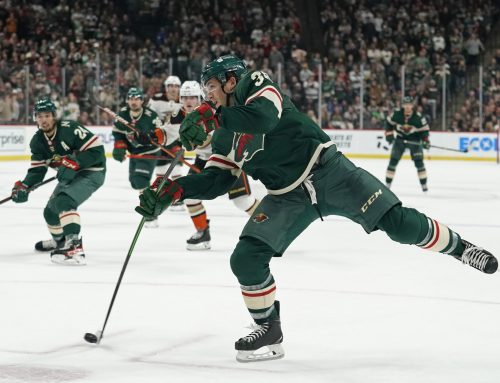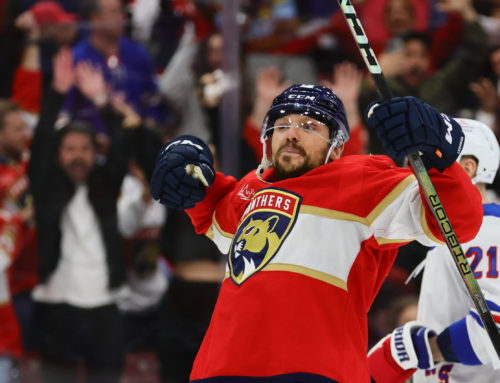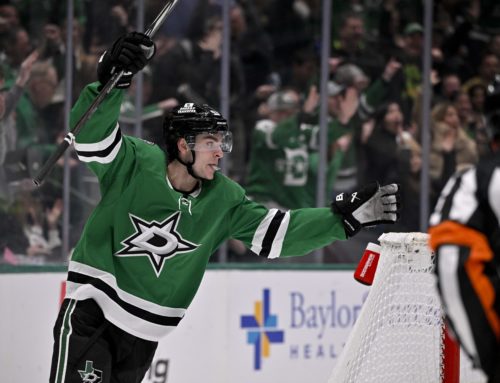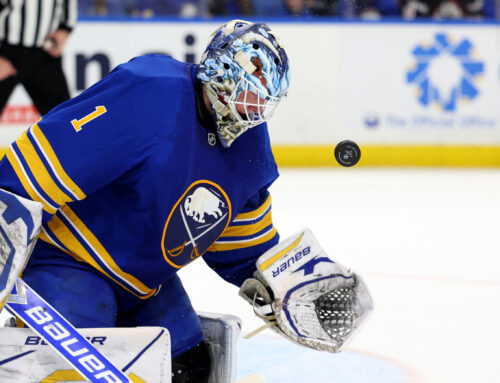
A few weeks ago, Rob Vollman posted his updated translation factors on Twitter. For anyone unfamiliar, it’s just the rate used to figure out what potential NHL production would look like. It is extremely helpful when trying make projections for the following year when there isn't an NHL track record. This is what it looks like:
Updated translation factors
.74 KHL
.58 SHL
.47 AHL
.43 SM-Liiga, Swiss NLA, NCHC
.38 H-East
.33 Big 10
.30 OHL
.29 WHL
.25 QMJHL
.23 ECAC— Rob Vollman (@robvollmanNHL) May 22, 2017
For those wanting a deeper dive into how this is calculated, and a whole lot more, grab Vollman’s Hockey Abstract.
There is still talk that Ilya Kovalchuk could make his way to the NHL. Using 57 non-power-play points in 60 KHL games, that works out to about 62 points in the NHL, should he decide to suit up in North American for 2017-18.
Something else to point out here is Kovalchuk led the league in shots last year with 245 in 60 games. Before leaving the NHL in 2013, the Russian winger had managed 678 shots in his most recent 195 contests, or nearly 3.5 shots per game. It does not appear as he’s lost his penchant for shooting.
What I want to do here is temper expectations a bit, should he decide to return. In those final 195 games, Kovalchuk managed 174 points, a 73-point pace per 82 games. That’s very good, but keep in mind that this was done playing 23:43 per game. There is no chance that he would come close to playing that much in the NHL now. Out of all forwards that played at least 50 games last year, the per-game minutes leader was Ryan O’Reilly at 21:27, and only 11 forwards cracked 20 minutes. Producing at his rate in those final three years, with about five minutes per game removed, would lead to somewhere between 55-60 points (close to Vollman’s translation).
It is extremely hard to be highly-productive in the modern NHL; there were just 26 players with at least 65 points in the 2016-17 regular season, less than one player per team. There was the same number of players with at least 30 goals, something Kovalchuk achieved every season from 2002-2012. Reaching either, or both, of those targets would be an exceptional feat. Should he return, hoping for that 70-point upside may be a pipe dream.
****
Earlier this week, the Los Angeles Kings re-signed winger Tyler Toffoli. He will earn $13.8 million over three years, and will be an unrestricted free agent at the end of the term. This signing now keeps a significant portion of the roster under contract for a few years as Anze Kopitar, Dustin Brown, Jeff Carter, Marian Gaborik, Tanner Pearson, Trevor Lewis, Kyle Clifford, Alec Martinez, Jake Muzzin, and Jonathan Quick are all signed through 2019-2020. Yes, some may be traded/bought out.
This is kind of a unique contract. It’s not necessarily a bridge deal, as bridge deals tend to finish with a player still in restricted free agency, giving the team control. It’s also not a long-term deal that we’d expect for a player his age that will be an unrestricted free agent. It’s almost a second bridge deal, which isn’t overly common (Gustav Nyquist signed one a couple years ago, and Chris Kreider signed something similar). This appears to be an attempt to keep their core together for a few years to see if they can manage one more Stanley Cup before rebuilding.
Regardless of the term of the contract, the AAV is great news for those in salary cap leagues. Players with true 30-goal and 60-point upside that aren’t high-end draft picks on ELCs aren’t readily available. His 2016-17 season took a hit in production, but injury and a poor shooting percentage are largely to blame.
Production problems with Toffoli, assuming health and normal luck, start and end with the power play. Over his last three seasons, he has 141 total points in 221 games, and just 23 of those points have come with the man advantage. Bear with me:
I hesitate to use NHL.com as a resource, but it’s all we have right now. Anyway, a cursory search with the following parameters returned 91 forwards: 2014-2017, at least 200 games played, and at least 0.6 points per game.
Of those 91 forwards, Toffoli (23) has the third-fewest power-play points, ahead of only Brandon Saad and Brandon Dubinsky with 21 each. There are 10 forwards with 31 or fewer power-play points over that span, and none of them managed 0.7 points per game over the last three years. There were 47 forwards with 46 or fewer power-play points over those three seasons (up to twice as many as Toffoli), and fewer than one-third of those players managed at least 0.7 points per game (14), and just three forwards managed at least 0.8 points per game.
That would mean that Toffoli: is capable of being a 65-point-or-better player, and will almost certainly not reach that mark unless he gets consistent top-line power-play minutes. This team could easily be another that uses four forwards and one defenceman on a top-heavy PP unit, with Kopitar, Carter, Pearson, and Toffoli. Whether they do it or not is another question. The other coaching issue for the new regime is ice time, as Toffoli saw his decline last year. He should be closer to 18 minutes in the real world. We’ll see if that actually happens.
****
Shots lead to goals. That sounds simple enough, but sometimes – especially if you’re hooked on pre- and post-game coverage in the playoffs – this can get a bit lost. In previous Ramblings, I’ve discussed certain players that posted solid shot rates last year which could translate to more success in 2017-18.
I thought it would be worth the time, then, going through some players who saw their shot rates increase in 2016-17 compared to 2015-16 at five-on-five. From the data at Hockey Analysis, I used the following parameters:
Forwards that played at least 500 minutes in each season at five-on-five. That would preclude injured players like Steven Stamkos, guys that get yo-yo’d between the AHL and the NHL, and rookies from this past campaign. That means guys like Jake Guentzel, Alex Radulov, and Patrik Laine, among many others, are excluded from consideration.
The reason for excluding such players is to look for even a brief pattern change, as well as finding undervalued players once fantasy drafts rolls around in a few months. Players like Guentzel and Laine will not be undervalued.
Below is a list of players that fit the above criteria, with the added filter of their shots per 60 minutes increasing at least 2.00 from 2015-16 to 2016-17:

Two players on this list we can probably remove from consideration: Andreas Martinsen and Lauri Korpikoski. Outside of a handful of specialized, or very deep, fantasy leagues, they aren’t productive.
Let’s discuss a few of these players.
Anyone in a league that counts hits as a category knows how valuable Clutterbuck can be. He also had just five goals, but that came on a career-worst 4.3 percent shooting. His 8.29 shots per 60 minutes at five-on-five is actually more a return to his norms; his first two years with the Islanders saw him land 8.58 shots per 60 minutes before the downturn in 2015-16. He’ll never be a true point producer, but he can improve on the five goals he managed.
The 20-year-old is a shooting machine. It’s not a surprise that his shot rate increased as he progresses early in his career, but the volume that he puts up is rarified air. I won’t get into him too much here, but barring an injury or poor luck, 30 goals is presumably a lock next year.
Eichel’s teammate and captain was a surprise to me on this list. Before the 2016-17 campaign, O’Reilly had only cracked 200 shots on goal once in his career (2013-14), and it was the only season that he also cracked 2.5 shots per game. He still isn’t shooting much overall – 7.37 shots per 60 minutes in 2016-17 was about mid-pack for players in his ice time range last year – but if he’s among the league leaders in ice time again, he should crack 200 shots again in a full, healthy season. I wouldn’t expect a downturn from last year’s production.
It was a weird year for Nugent-Hopkins. He set a career-high in shots on goal per 60 minutes (8.13) and Individual Points Percentage (IPP) at 76.5 percent, which is the rate at which he garners a point when the team scores with him on the ice. Despite this, he had the lowest five-on-five point total of any season in which he’s played at least 60 games. The main reason was he was on the ice for 1.89 goals per 60 minutes, one of the lowest marks in the league for heavily-used forwards.
That is all besides the point. The point is he cracked 200 shots for the first time in his career, a good sign for personal production moving forward. It is a good thing his personal shot rate jumped so much, because he played his fewest minutes per game since his rookie season. With Connor McDavid getting so much ice time, that may not change anytime soon. Regardless, if he can maintain this shot rate, with even a marginal rebound in his team’s on-ice shooting percentage, he should be back over the 50-point plateau in 2017-18.
Trying to gauge Eaves’ season is probably pointless. He spent nearly over 70 percent of his ice time playing with at least one of Jamie Benn, Tyler Seguin, or Ryan Getzlaf (per Puckalytics). He’s an unrestricted free agent, so there’s no telling where he lands, or on which line. The fact that he shot as much as he did when given the opportunity to play at the top of a lineup, however, is something to keep in mind depending on where he signs.





 EDM
EDM FLA
FLA CHI
CHI ANA
ANA L.A
L.A OTT
OTT
